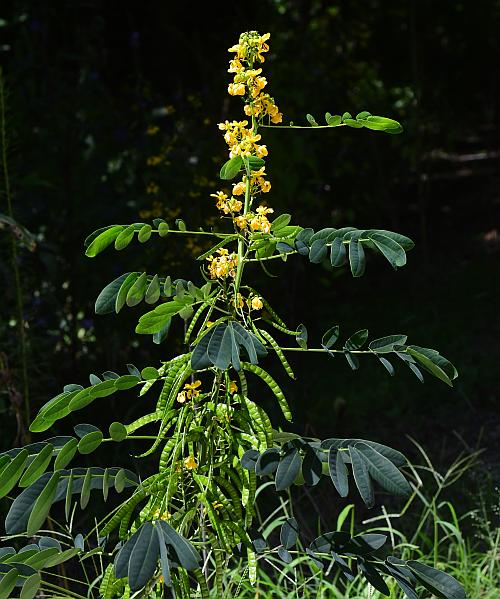Senna marilandica (L.) Link
Southern Wild Senna

Native
CC = 4
CW = 0
MOC = 69
© SRTurner
Senna marilandica (L.) LinkSouthern Wild Senna | |
 |
Native CC = 4 CW = 0 MOC = 69 |
© SRTurner |
|
Family - Fabaceae/Caesalpinioideae Habit - Perennial forb with a somewhat woody, often horizontal, branched rootstock, not fragrant. Stems - Ascending to erect, to 2.0 m, 1 to several, unbranched, glabrous or sparsely pubescent with spreading hairs toward the tip, sometimes somewhat glaucous, often with "zig-zag" growth pattern near apex.
Leaves - Alternate, petiolate, even-pinnate. Petioles 3-6 cm long, the petiolar gland positioned near the base, 1-2 mm long, ovoid to hemispherical or more or less short-cylindrical, appearing sessile and broadest at or below the midpoint. Leaf blades 14-20 cm long, with 8-10 pairs of leaflets. Leaflets 3.0-6.5 cm long, 10-25 mm wide, oblong to oblong-elliptic, oblique at the base, abruptly short-tapered to a minute, sharply pointed tip, the margins with a pale, narrow band and short, ascending hairs, the surfaces glabrous or the undersurface with scattered microscopic glandular hairs (at least when young), the undersurface also pale and somewhat glaucous. Petiolules to 2.5 mm long, sparsely pubescent.
Inflorescences - Axillary racemes with 6-9 flowers, often appearing aggregated in terminal clusters, the flower stalks 10-15 mm long, lacking bracts.
Flowers - Sepals 5, free, somewhat unequal in size, variously 4-8 mm long, 3-4 mm wide, ovate, bluntly pointed at the tip, the margins short-hairy. Petals 5, free, 7-12 mm long, 4-5 mm wide, oblanceolate to obovate, yellow. Stamens 10, unequal, with the anthers purplish brown. Upper 3 stamens much reduced. Lower 3 stamens to 1.2 cm long. Filaments glabrous, yellow. Style green, 3 mm long. Ovary 4-6 mm long, with short, appressed hairs, the style 2-3 mm long.
Fruits - Legumes 6-9 cm long, 7-10 mm wide, arched downward at maturity, strongly flattened, sparsely to moderately hairy when young, becoming glabrous at maturity, conspicuously impressed between the seeds, dark brown to black at maturity. Seeds 4-5 mm long, 2.2-3.0 mm wide, oblong-obovate to obovate, slightly flattened, the surface often developing a fine network of cracks toward the margins at maturity, olive green to brown, more or less dull, the pleurogram usually slightly grayer than the remainder of the seed.
Flowering - July - August. Habitat - Streambanks, sloughs, prairies, forests, bluffs, glades, savannas, pastures, fields, roadsides, open, disturbed areas. Also cultivated. Origin - Native to the U.S. Lookalikes - Other species of Senna, but these are rare in Missouri. Other info. - This is a common plant in the state, probably found statewide though less commonly in the northwest. It is also found in somewhat scattered form across most of the eastern half of the continental U.S. It is recognized by its pinnate leaves and elongate inflorescences of yellow flowers. The stamens are of different sizes, with large brown anthers which contrast conspicuously with the yellow petals. The plants seems to prefer a moist soil location, and can grow in full sun or light shade. Being a perennial with a shrubby growth habit, it seems ideal for cultivation and is frequently planted for ornamental use. Photographs taken in the Ozark Scenic Riverways, Shannon County, MO., 7-22-04 (DETenaglia), also at Shaw Nature Reserve, Franklin County, MO, 8-26-2006 and 8-9-2008, Weldon Spring Conservation Area, St. Charles County, MO, 8-15-2010, and along the Katy Trail near Augusta, St. Charles County, MO, 8-4-2013 (SRTurner). |